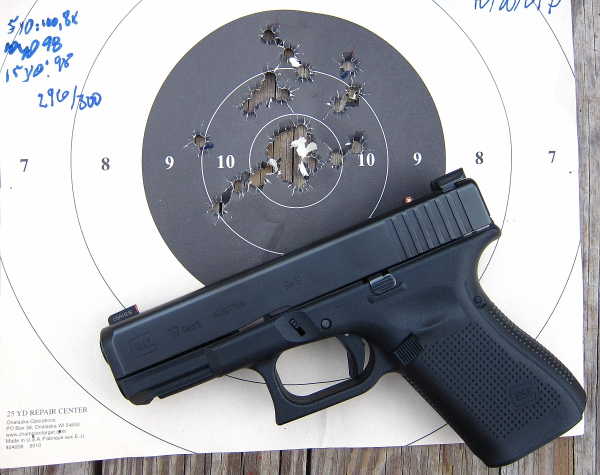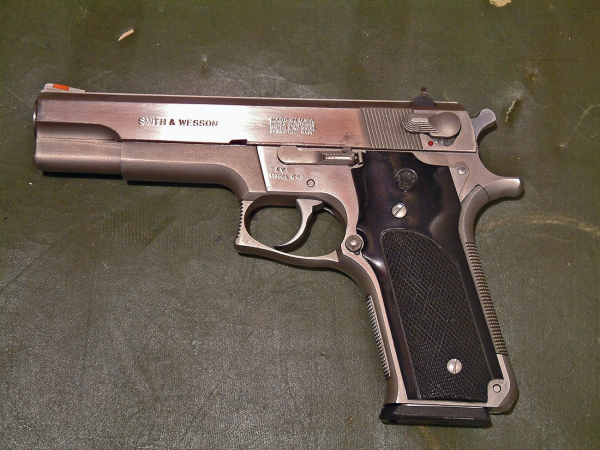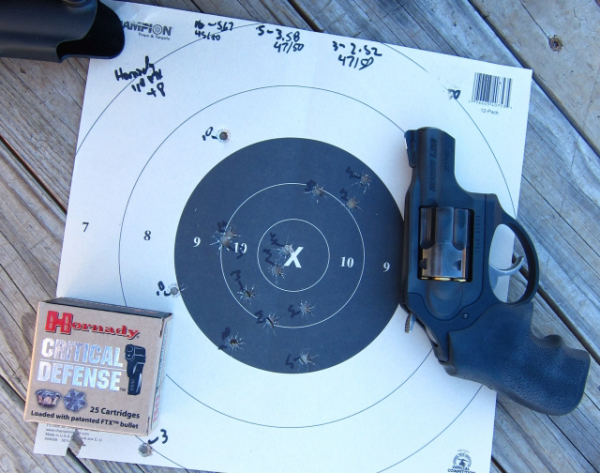I was confronted by a correspondent recently who expressed disbelief at a photo depicting a target in a recent feature. It was incredible, he noted in a comment, that shooting that fast at that small a target could lead to that result.
I didn’t think much about it – it frankly was a less than perfect target and I place my skills at the middle range for someone of my years and experience. Still, many things can appear impossible to those who simply haven’t tried to do it. It has to do with putting in the work and it’s not just a sudden flurry of activity but structured work over time. There’s simply no substitute.

This was not the target in question, though it likewise falls short of perfection. Regular planned, dedicated practice drives favorable results.
Yes, I know certain genetic freaks that can ‘knock the wings off a gnat from the holster in a tenth of a second,’ but even those gifted individuals put in work – dedicated practice – to ensure the high level of skill.
And I’m joking about the gnat and the tenth-second draw to a hit.
I’ve had people in classes stress out over a walk-back drill. I’ve psyched myself out shooting bullseye, PPC, IPSC and other action events and even certain benchmark qualification courses at various locations.
Dedicated practice minimizes that tendency. It becomes “another day at the office,” doing what we always do.
Recently, I was engaged in the geezerly activity as “down-sizing,” an activity in which you discard a lifetime of amassed junk, ‘treasures’ and other stuff. I found my range notes from 1988 – 1996. I still had them in an old range bag that had gone unused since the Clinton Administration.

The old war horse, the S&W M645 issued in 1986 and taken off the road in 1994. According to notes, there was more practice with this -- the issued carry piece -- than any other firearm during the time the notes were taken.The gun below is a M4563 TSW, a bit shorter and with an alloy frame, present for testing in the years after the notebooks were composed.
Looking at them, I see primarily PPC work using the company-issued S&W 645 at the start. I practiced with that gun regularly, shooting the “left hand accuracy test,” plus various courses shooting other guns that wandered through my life – carefully documented for me to track my own performance. It wasn’t particularly fast shooting, but it was working to stop the misses – the “minus-1s” of my seemingly inevitable flinch that I fought since 1983. I find that on 31 January 1989, at our local club range, it was a balmy 70? degrees, sunny with winds gusting from the west – just one of the tidbits of treasure from the old notes.
I apparently thought it critical to look at performance relative to climatological conditions. I collected scores off of fired targets and noted the target used for reference. I noted malfunctions, whether or not a photo was taken, collecting an image of the scene. This was back in the film days, not so easy as digital imagery today.
I found a record of a “left hand qualification” shot with my first backup gun, an S&W Model 60 habitually carried accessible to my left hand, hence the reason for shooting it from that side. In my notes from April 1988, I find that I fired stages at 25, 15, 7 and 5 yards, ending with a 3-yard, ‘close combat’ left-handed workout using +P ammo. The scoring, on an NRA B-27 repair center, showed four rounds in the “8” ring, with the remainder in the “9” and “10.”

It seems the smallest guns require the longest apprenticeship. It's worth doing.
That’s not any sort of magic or trickery. It’s not a natural gift. It was something at which I had to dedicate time and effort.
Towards the end, I found that I’d tried to compare the S&W M4566, a “commander-” length 4506 against a Model 5906, the double-stack 9mm that I just never could shoot well. The experiment consisted of timed events, each a single hit from the draw. From security holsters, those with more than a simple thumb-break strap, I was just .2 second average quicker with my favored 45 (it felt slimmer, gave me better reach to the trigger) over the clunky 9mm.
So much for “feel” as a predictor of capability.
I’d also done a range trip to analyze for myself the difference in time between a shot fired from a random start with the gun “on target/on trigger” and the new-to-me-then “universal cover mode” – gun off target at “guard” and trigger finger at register. The difference averaged around .3 second in 1996 – the blink of an eye – with a few efforts getting down to the .22 second difference.
Recently, I did the Larry Vickers “on target, on trigger” drill, for trigger control, and averaged .2 seconds, breaking the shot during the timer’s tone.
What does all that mean? I had a plan, I had experiments to try out to determine where I was and where I could go. It’s hard to complete a journey without some idea how you’re getting there – and how to know when you have arrived.
- - Rich Grassi